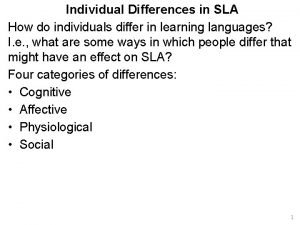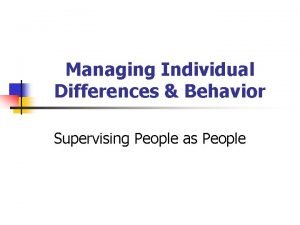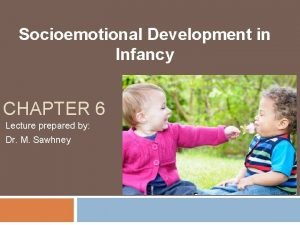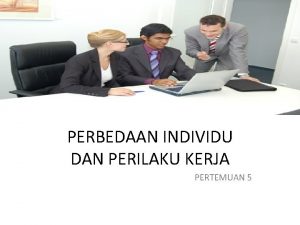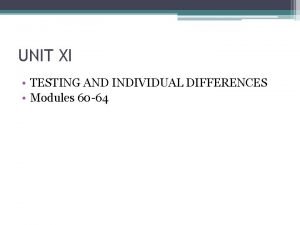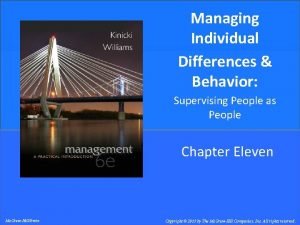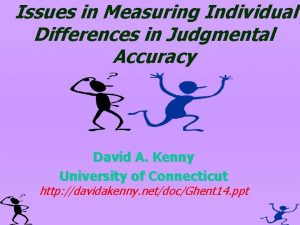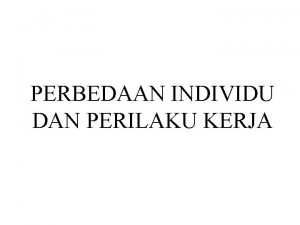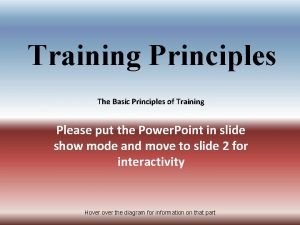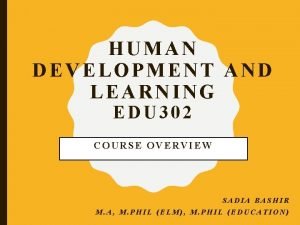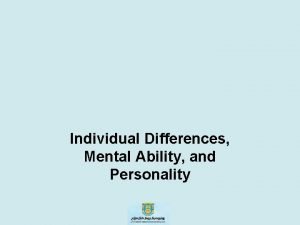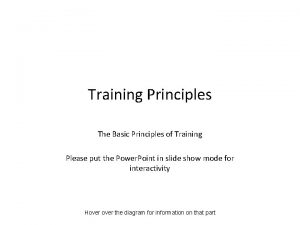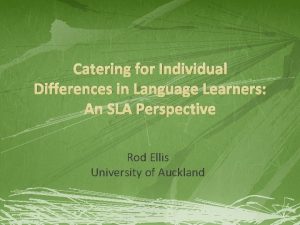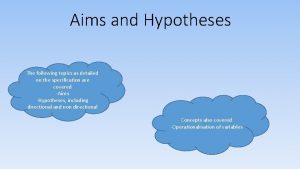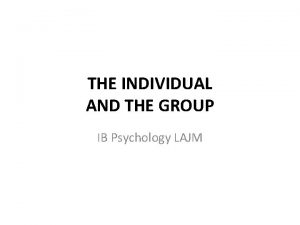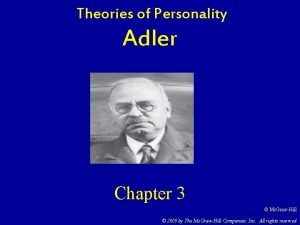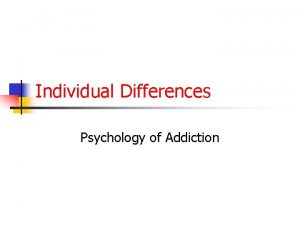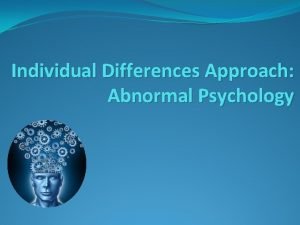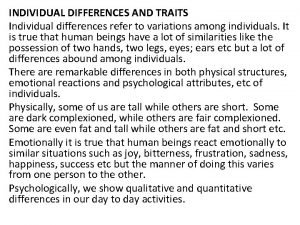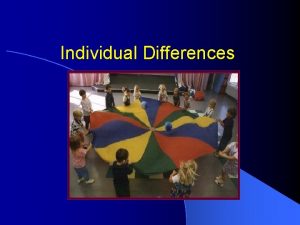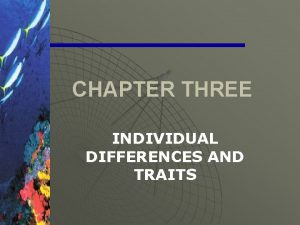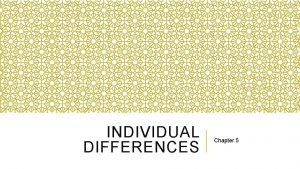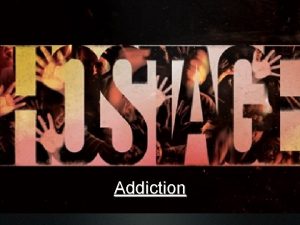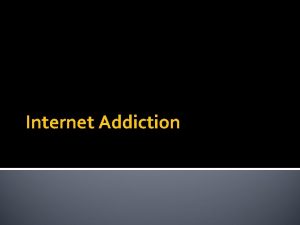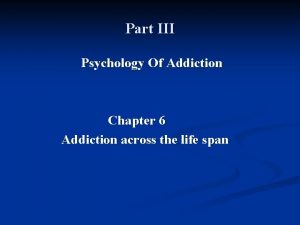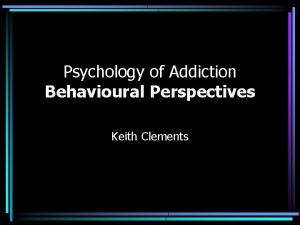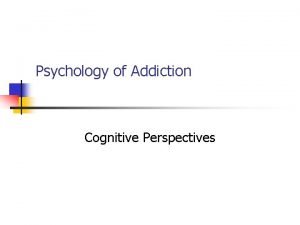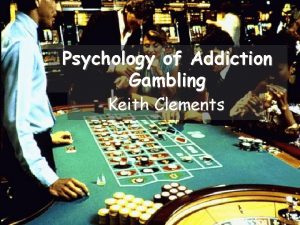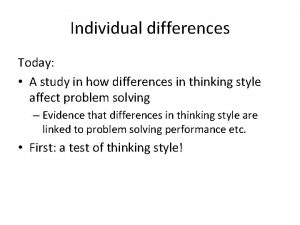Individual Differences Psychology of Addiction Aims n n




















- Slides: 20

Individual Differences Psychology of Addiction

Aims n n To consider the extent to which personality traits predict substance use and abuse. To examine the relationship between substance use, psychological distress and psychopathology.

Problem behaviour theory n n Jessor & Jessor (1977) suggested that there was a cluster of problem behaviours occurring in adolescence. They suggest these are manifestations of a common syndrome. Reflects unconventionality (Donovan & Jessor, 1985) Three categories of risk factor, typically act together n n Demographic Perceived social environment Personality Proximal & distal influences within each

Lynskey et al (1998) Analysed use of tobacco, alcohol & cannabis by 1265 16 -year olds, as reported by parents and self Risk factors included n n n Reports of ‘delinquent’ behaviour by peers** conduct problems Novelty seeking (TPQ)** Gender Parental use of tobacco & illicit drugs SES ** strongest predictors Supported a general vulnerability factor. Three risk factors; peer behaviour, novelty seeking & parental use of illicit drugs.

Sensation seeking Seeking varied, novel, complex & intense sensations & experiences The willingness to take physical, social, legal & financial risks for the sake of such experience Zuckerman (1994) Originally linked to optimum arousal level. Now related more to impulsivity and sensitivity to reward. Subscales n Disinhibition n Experience Seeking n Boredom Susceptibility n Thrill and Adventure Seeking Probably more important in the early stages of substance use, (Zuckerman, 1983)

Sensation-seeking & alcohol n n Evidence to link all four of Zuckerman’s subscales with alcohol use Most support for Dis, with some for BS and ES, and less for TAS n maybe the nature of scales can explain the relationships Forsyth & Hundleby, 1987 n n n College students Removed confounding items from Dis scale Frequency of drinking correlated with Sensation seeking and with Extraversion Asked about drinking situations; boring, ceremonial, convivial, stressful Sensation seekers reported more drinking in boring situations Neuroticism predicted reported drinking in social and stressful situations (but not overall consumption)

Smokers are typically found to have higher sensation seeking scores than non-smokers n Past smokers may not differ from current smokers, level of smoking within the group may not correlate with sensation seeking (Kuckerman & Neeb, 1980; Von Knorring & Oreland, 1985) High sensation seeking is associated with alcoholism with an early onset and more social problems (Von Knorring , Palm & Anderson, 1985; Galizio, Gerstenhaber & Friedenson, 1985.

Illicit drug use Sensation seekers are likely to be polydrug users (Zuckerman 1994) Study of adolescent drug use (Andrucci et al. , 1989) total SS, ES and Dis significantly differentiated users v nonusers for various drugs n None of the drugs were preferred by low sensation seekers n Anxiety & Depression were only predictive of Barbiturate use. Conway et al. (2002) found abuse/dependence on any substance was associated with low constraint (High SS). Constraint varied as a function of the social deviance of the drug abused or preferred.

Methodological issues n Possible confounding items e. g. I like “wild” uninhibited parties or keeping the drinks full is the key to a good party (both taken from the DIS scale) n n Different, yet overlapping, scales Determining causality Cause or consequence of drug use? Factors influencing initial entry or success in quitting? n Evidence from Behaviour, Personality, Comorbidity?

Substance use and psychopathology n n n Degenhardt, Hall & Lynskey (2001) Large community sample Measured use of alcohol, tobacco and cannabis, plus DSM abuse & dependence of alcohol and cannabis. All levels of cannabis & tobacco use predicted other disorders. J-shaped relationship for alcohol. Alcohol dependence & cannabis or tobacco use predicted anxiety and affective disorder. Not independent of other predictors for cannabis use. Alcohol dependence & cannabis or tobacco use predicted psychosis scores. Not independent of other predictors for alcohol.

Personality traits related to psychopathology Neuroticism n Increased emotionality (Eysenck) n Sensitivity to punishment (Gray, 1981) n Related traits n Trait anxiety n Negative emotionality Schizotypy Traits related to those observed in schizophrenia. Include n unusual beliefs & experiences n Introvertive anhedonia n Cognitive disorganization n Impulsive nonconformity Eysenck’s Psychoticism scale was originally claimed to measure psychosis -like traits. Now more closely related to sensation seeking & antisocial personality disorder.

Smoking n Smith (1970) smokers showed greater extraversion (22/25 studies) and neuroticism (24/50 studies) n Gilbert (1995) reports that later studies show weaker relationships with E (18/28), but stronger relationships with N (21/30). Smoking is strongly correlated with psychoticism Illicit drugs Heroin addicts have higher N and P, and lower E (Lodhi and Thakur, 1993; Gossop and Eysenck, 1983)

Substance use and schizotypy Williams, Wellman & Rawlins 1996 n Cannabis use associated with high scores on Claridge & Broks (1984) Schizotypy & Borderline scales and with Eysenck’s Psychoticism scale n STA and STB correlate more reliably with cannabis use than P or N Larrison, Briand & Sereno (1999) n Positive-symptom schizotypy scale (Rust, 1988) in relation to use of nicotine, caffeine & alcohol, n=285. n Schizoptypy correlated positively with smoking status and negatively with alcohol consumption. n Smoking status interacted with caffeine consumption. For nonsmokers schizotypy increased with level of caffeine use.

Cannabis use & psychosis n n Recent studies have demonstrated that cannabis use does contribute to an increase in the risk of psychosis, even when assessed prior to the development of symptoms. There is a dose response relationship between the level of cannabis use and the risk of developing schizophrenia during the follow-up period (see review by Smit, F. , Bolier, L. , & Cuijpers, 2004).

Smoking & Negative affect Parrott (1994) 105 subjects completed stress and arousal scales before and after each cigarette. Overall: n Smoking increased arousal and decreased stress. n Mood worsened between cigarettes Subjects who reported smoking for sedative effects showed a greater reduction in stress. Subjects who reported smoking for stimulant effects showed a greater increase in arousal. Individual differences were primarily due to differences in precigarette stress & arousal scores.

Smoking as self medication? n n n Parrott (1998) suggests that mood changes after smoking are primarily due to withdrawal relief. He also suggests that elevated Neuroticism scores in smokers may reflect the repeated experience of nicotine withdrawal over the course of the day. Gilbert et al. (1998) present data suggesting that this association may, in part reflect self medication. Smoking correlates with negative affect, there may be a reciprocal relationship (Kassell et al, 2003).

Drinking as self medication? n n A variety of psychological problems are more common in heavy drinkers. However, as with smoking, this evidence is largely retrospective. In the laboratory alcohol may have inconsistent effects on mood. Dose, individual differences, expectancies and procedural factors may all influence the occurrence and direction of changes in anxiety following alcohol consumption.

Cognitive models Sayette's Appraisal-Disruption model n Alcohol disrupts appraisal. n Intoxication prior to appraisal may prevent the appraisal of events as stressful n Intoxication after this appraisal will not reduce stress, it may impair the appraisal of coping resources and increase perceived stress. Several other theories link alcohol's presumed stress-reduction effects to reduced processing of threatening information. n e. g. Hull (1981) suggested alcohol may reduce self-awareness. In a similar vein, Kassel & Shiffman (1997) reported that smoking reduced anxiety only when subjects were presented with a benign distractor task. Under some circumstances smoking might reduce anxiety by narrowing attention.

Further Reading n n Jung, J. (2001). Psychology of alcohol and other drugs : a research perspective. London: Sage Publications. n Chapter 10 covers methodological issues and different models of the relationship between personality and drug use. Zuckerman (1994) Behavioural expressions and biosocial bases of sensation seeking. Cambridge University Press. Acton , G. S. (2003). Measurement of Impulsivity in a Hierarchical Model of Personality Traits: Implications for Substance Use & Misuse, 38, 67 -83. Available online at: http: //www. personalityresearch. org/acton/impulsivity. html Smit, F. , Bolier, L. , & Cuijpers, P. (2004) Cannabis use and the risk of later schizophrenia: a review. Addiction, 99, 426 -431.

Selected articles Degenhardt, L. , Hall, W. & Lynskey, M. (2001) Alcohol, cannabis and tobacco use among Australians: A comparison of their associations with other drug use and use disorders, affective and anxiety disorders, and psychosis. Addiction. 96 603 -1614 Gilbert, D. G. et al. (1998). Effects of smoking abstinence on mood and craving in men: Influence of negative-affect related personality traits, habitual nicotine intake and repeated measurements. Personality & Individual differences, 25, 399 -423 Kassell, J. D. , Stroud, L. R. & Pavonis, C. A. (2003). Smoking, stress and negative affect: Correlation, causation and context across stages of smoking. Psychological Bulletin, 129, 270 -304. Parrott, A. C. (1998). Nesbitt's Paradox resolved? Stress and arousal modulation during cigarette smoking. Addiction, 93, 27 -39 Sayette, M. A (1993). An appraisal-disruption model of alcohol's effects on stress. Psychological Bulletin, 114, 459 -476
 Individual differences in sla
Individual differences in sla Managing individual differences and behavior
Managing individual differences and behavior Thomas and chess temperament
Thomas and chess temperament Perbedaan individu dalam organisasi
Perbedaan individu dalam organisasi Unit xi testing and individual differences
Unit xi testing and individual differences Proactive personality
Proactive personality Conclusion of individual differences
Conclusion of individual differences Kerangka kerja perilaku individu
Kerangka kerja perilaku individu Variation principle of training
Variation principle of training Individual differences in second language learning
Individual differences in second language learning Edu 302
Edu 302 What are type a people
What are type a people Principles of training individual differences
Principles of training individual differences Catering for individual differences
Catering for individual differences What is health psychology
What is health psychology What is a directional hypothesis in psychology
What is a directional hypothesis in psychology Stereotypes ib psychology
Stereotypes ib psychology Adler theory
Adler theory Ap psychology chapter 13 social psychology
Ap psychology chapter 13 social psychology Health psychology definition ap psychology
Health psychology definition ap psychology Social psychology ap psychology
Social psychology ap psychology
